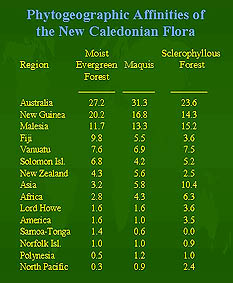 |
QUICK SEARCH
MO PROJECTS:
Africa
Asia/Pacific
Mesoamerica
North America
South America
General Taxonomy
Photo Essays
Training in Latin
America
MO RESEARCH:
Wm. L. Brown Center
Bryology
GIS
Graduate Studies
Research Experiences
for Undergraduates
Imaging Lab
Library
MBG Press
Publications
Climate Change
Catalog Fossil Plants
MO DATABASES:
W³MOST
Image Index
Rare Books
Angiosperm
Phylogeny
Res Botanica
All Databases
INFORMATION:
What's New?
People at MO
Visitor's Guide
Herbarium
Jobs & Fellowships
Symposium
Research Links
Site Map
Search
Diversity, Endemism, and Extinction in the Flora and Vegetation of New CaledoniaPhytogeographic AffinitiesThe phytogeographic relations of the New Caledonian flora have interested botanists for many years (e.g., Balansa, 1873; Balgooy, 1960, 1971; Baumann-Bodenheim, 1956; Guillaumin, 1921, 1924, 1934, 1953; Thorne, 1963, 1965, 1969), and have recently been analyzed in detail for the moist evergreen forests (Morat et al., 1984), the maquis (Morat et al., 1986), and the sclerophyllous forests (Jaffré et al., 1993). Together these formations include nearly 82% of the native species (almost 70% of the genera) and cover about 45% of Grande Terre (including nearly all of the remaining primary vegetation), and thus comprise a representative sample of the flora for analysis of its affinities with other areas (Lowry, 1991). Using correlation coefficients calculated for 15 phytogeographic regions (cf. Morat et al., 1984), the relative importance of the floristic relationship between New Caledonia and each of those regions can be expressed as a percentage of the total of the correlation coefficients.  The results are very similar for each of the three principal vegetation types, strongly suggesting that despite the many differences in the details of their floristic composition, they have a fundamentally similar history and a common set of origins, as well as a shared set of mechanisms responsible for their establishment (Jaffré et al. 1993). Phytogeographic affinities are by far strongest with Australia, New Guinea, and Malesia, which is consistent with the hypothesis that the New Caledonian flora comprises two principal elements: 1. Ancient Australasian (Gondwanan) Element - Present when New Caledonia separated from Australia 2. More Recent Element from New Guinea and Malesia - Arrived by Long-distance dispersal Comparatively few groups show affinities with other tropical Pacific islands such as Fiji, Vanuatu, the Solomons, and Samoa-Tonga, or with areas to the south (Norfolk Island, Lord Howe Island, and New Zealand). In the case of the tropical Pacific islands, as well as Norfolk and Lord Howe, this is probably because they constitute rather small source and target areas for long-distance dispersal, coupled in some cases with their young age (i.e., for the volcanic islands of recent origin) and their generally less diversified climatic and edaphic conditions. The low phytogeographic affinities with largely temperate floras to the south (especially New Zealand’s) result primarily from the strong climatic differences between the territories.
|
© 1995-2025 Missouri Botanical Garden, All Rights Reserved
4344 Shaw Blvd.
St. Louis, MO 63110
(314) 577-5100
Technical Support